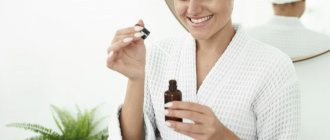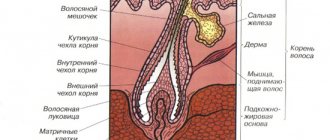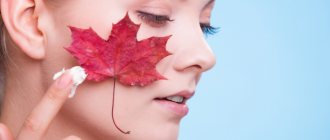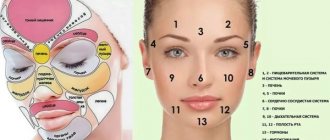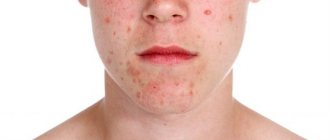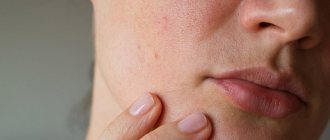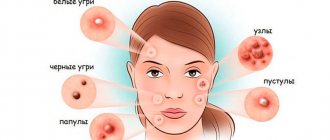Facial rash is a problem that affects both teenagers and adults. Even newborns can get acne. Rashes are caused by different factors, so approaches to their treatment also differ.
Before buying medications or using folk remedies, you must undergo a full examination. Based on the results, the doctor will prescribe a complex therapy that eliminates not only external manifestations, but also the cause itself. It is recommended to consult a specialist for any rash, since it is impossible to make a diagnosis on your own.
- Types of comedones
- Drug therapy and diet
Allergic rash
The rash can look different. The following types of allergies are typical:
| View | Peculiarities |
| Papules | Elements that rise above the surface of the skin, most often a red or bright pink rash. It can have different sizes. But in most cases it is small, the size of a millet grain. In severe forms of the disease, papules merge with each other, forming large raised spots |
| Vesicles | Watery elements that rise above the surface of the skin, up to 5 mm in diameter, containing a yellowish serous fluid. Often formed due to allergies to insect bites |
| Bubbles | They are cavity elements with liquid contents, which are usually filled with a transparent liquid. If the top of such a bubble is opened, it dries out and a crust forms on top. Sometimes erosion forms - a red, weeping surface |
Allergies on the skin of the face are manifested by flat red spots and scales, that is, detachments of the epidermis. Areas with this rash quickly begin to itch.
Allergic dermatitis, accompanied by all the described symptoms, is the body’s reaction to facultative stimuli, that is, substances that are perceived by it as foreign from a genetic point of view. They are called allergens. The causes of the rash are contact with the following substances:
- chemical agents - components of varnishes, paints, hardeners, turpentine, etc.;
- compounds contained in cosmetics and perfumes - ursol, paravenylenediamine, pigments, other ingredients of lipstick, toothpaste, etc.;
- substances present in medications - analgesics, antiseptics and antibiotics;
- some metals - cobalt, copper, nickel and chromium compounds;
- plant proteins contained in pollen of cereals, trees and grasses;
- toxic substances that enter the body through insect bites;
- some polymers, both natural and synthetic origin.
Special tests prescribed by your doctor will help identify the allergen.
Treatment
Treatment for an allergic rash on the face involves stopping contact with the irritant. Then general and external therapy is prescribed, which helps relieve inflammation and get rid of itching. Allergic dermatitis is treated at home.
The exception is severe cases when it develops against the background of other diseases or the allergic reaction is so strong that it is accompanied by Quincke's edema.
Drug therapy
Products that reduce sensitivity to the allergen are used. These include sodium thiosulfate, calcium gluconate or calcium chloride. All of them are administered intravenously, the dosage is determined by the severity of the allergic reaction.
Antihistamines are also prescribed. These include Fenistil (it is allowed even for infants, starting from the age of two months; children can take drops). The gel is used for external treatment, applied to the affected areas of the skin.
Other second-generation systemic drugs are also used - Terfenadine, Astemizole, etc.
Among diuretics, it is recommended to give children milder ones, for example, Diacarb.
Furosemide is also suitable for adults. Their use will help quickly remove toxins and foreign substances from the body.
Among the enterosorbents, which are also indicated for allergies, activated carbon is safe, but does not act quickly enough, so it is recommended to replace it with Enterosgel and Polysorb. They do not harm the body and work more efficiently.
As for external therapy, it consists of the use of various lotions, water-zinc paste and other similar products. Lotions are made on the basis of boric acid or Furacilin. If the rash is severe, ointments with glucocorticoids are used. This is, for example, hydrocortisone ointment.
Folk remedies
There are also traditional methods for eliminating allergic rashes. The most effective include:
- Compresses based on herbal infusions of oak bark, calendula flowers, lemon balm herb and horsetail, and elecampane root. They are all prepared the same way, in the proportion of 1 tbsp. l. per glass of boiling water, infuse for at least an hour and strain before use.
- Herbal infusions for oral administration. They are prepared from currant or viburnum bark, chamomile flowers or tricolor violet, licorice root (1 tablespoon of raw material per glass of boiling water).
Herbal compresses are also suitable for children. They soothe the skin, the child will itch less.
Despite the abundance of remedies used for treatment at home, it is imperative to consult a doctor, since only he can make a diagnosis and determine the allergen based on test results.
Therapy for pregnant women
It is not recommended to take antihistamines during pregnancy, especially in the first trimester. However, an allergic rash in this group of patients also requires treatment, since there is a risk of secondary bacterial infection.
Steroid creams and ointments are suitable for external use. They should be applied only to the affected areas of the face. It is recommended to consult a doctor first, but the general rule is as follows: first use the weakest means, for example, hydrocortisone ointment, if this does not help, you need to move on to a stronger one.
The amount of the drug applied should be minimal. Even in the most severe form, the use of creams is considered preferable to the use of tablets. Of the latter, Prednisolone is mainly used during pregnancy, which is used only as a last resort. The drug is prescribed only for a short time.
Liver and intestinal problems
Various intestinal problems can also affect the skin. And if there is liver disease at a fairly serious stage, then the skin will change its shade to yellow, for example, with the same hepatitis, which is popularly called jaundice precisely because of the characteristic coloring of the skin.
Dangerous spots. What diseases may skin problems indicate? Read more
Acne
If acne appears on the skin, it can be the result of poor care or poor nutrition, or it can be hormonal in nature. They occur not only in teenagers, but also in adults.
Varieties
Acne can look different, so diagnosis and subsequent treatment largely depend on its appearance.
The main types of rashes are as follows.
Comedones
Elements of the rash are non-inflammatory. They may appear as a result of the fact that the mouths of the sebaceous hair follicles become clogged for some reason.
Comedones can be open (often white) and closed (so-called blackheads). These elements are found in all types of acne. Most often they are located on the skin of the forehead and chin, and nose.
Papulopustular acne
These are inflammatory elements. Sometimes these are sudden rashes, but most often they gradually develop around comedones if the latter do not receive proper treatment. Papules are convex hemispherical elements, usually red in color, which are caused by inflammatory processes.
After such a rash goes away, scars or spots form in its place, which also have to be dealt with.
Indurative acne
They are extensive subcutaneous infiltrates of an inflammatory nature.
At the same time, visually they look like a bumpy surface of the skin.
Acne conglobata
They are large painful nodes that form in the upper part of the subcutaneous fat or even deeper in the dermis.
In this case, severe inflammation can lead to unpleasant consequences, for example, the development of an abscess.
Any skin manifestations described vary in severity. They also occur with different frequencies in men and women. For example, girls most often encounter comedones and papulopustular acne. In men, in most cases, acne conglobata develops.
Childhood acne
They are divided into newborn acne and infant acne. The first ones can appear literally on the 3-5th day of life. Their appearance is due to the fact that the newborn’s body is still influenced by maternal hormones. But sometimes the reason is that the child’s hormone production has been disrupted since birth. Such acne appears on the cheeks, forehead, and chin. Usually these are single comedones. Even if they are not treated, they will go away spontaneously, approximately by the time the child is 2-3 weeks old, or at most a month.
Infantile acne also often develops in infants under 6 months of age. They also have a hormonal nature, associated with a temporary increase in testosterone production. Often the rash goes away within a year, without special treatment.
But if it is persistent acne, then the cause may be a dysfunction of the adrenal glands. This type of acne is usually represented by a papulopustular rash.
Youth
They are also hormonal in nature. They are represented mainly by comedones and papulopustular rashes, but conglobate acne is also found, especially in young men.
Such a rash should completely regress by the age of 17-20 and not appear again.
Adult acne
They are represented by various types of rashes, including comedones, papules, and indurative forms. In an adult, they can be caused by improper skin care. But most often they appear against the background of hormonal changes.
In women, rashes are associated with PMS or pregnancy, increased production of male hormones (then they are accompanied by hirsutism - growth of facial hair).
In men, acne can be caused by excess androgen production.
Contact and comedonal form
Contact acne is associated with exposure to some irritants, such as cosmetics. Most often these are products such as lipstick, petroleum jelly, creams containing lanolin, and cosmetic oils.
The comedonal form is caused by exposure to physical agents (direct sunlight).
Acne treatment
You should consult your doctor for diagnosis and treatment instructions. External remedies alone are not always enough to remove acne.
Complex hormonal therapy is often used, since the rash in this case is only an external manifestation of the disease. It is prescribed individually, after a full examination. Acne conglobata may require surgical treatment in a clinical setting.
Drug therapy and diet
Acne must be treated comprehensively, using systemic and external therapy and simultaneously eliminating the causes that led to the formation of acne. An important role is played by a diet that limits animal fats and fast carbohydrates (baked goods, sweets) by increasing the proportion of vegetable fats, fiber and vitamins.
More attention should be paid to cleansing the skin. You need to use lotions and soaps with a neutral or acidic pH. You will have to temporarily abandon scrubs, as they destroy the protective water-lipid layer and aggravate the production of sebum, leading to the formation of comedones.
For severe rashes, take antibiotics orally for 2-3 weeks. These are drugs such as Azithromycin, Doxycycline, Erythromycin, Biseptol. Caution should be exercised as such drugs can be very allergic. At the same time they take immunomodulators - Cimetidine.
With mild acne, you can often limit yourself to only external therapy and cosmetic procedures. If you have closed comedones and sebaceous gland cysts, it is recommended to contact a cosmetologist who will perform their mechanical removal. When open comedones predominate, products based on salicylic acid are used, which have antiseptic properties and dry out the skin.
Creams with synthetic retinoids are recommended for everyone except pregnant women for all forms of acne. These are drugs such as Adapalene, Tretinoin, Skinoren (based on azelaic acid). It is important to remember that retinoids are used simultaneously with exfoliants and peels.
Topical antibiotics are often used - erythromycin and tetracycline ointments, Clindamycin and others. Such products are applied pointwise to the elements of the rash twice a day.
The beauty salon uses techniques such as ultraviolet irradiation and drying masks based on anti-inflammatory components - white clay, zinc, menthol. Cosmetic clay can also be used at home.
ethnoscience
There are also folk remedies against acne:
- Lotions based on 1 tsp. pharmacy tincture of calendula mixed with the same amount of buckwheat honey. They are applied to the affected areas for 30 minutes, then washed off with cool water.
- Aloe leaf juice. Used to wipe the skin instead of lotion.
- Decoction of birch buds (1 tbsp per glass of boiling water). Keep on low heat for 20 minutes, cool, filter, and use as a cleanser.
A classic decoction of chamomile, sage or St. John's wort (1 tbsp per glass of boiling water) will be useful.
Treatment during pregnancy
During pregnancy, women often experience acne on their face. The reason is the hormonal changes in the body that occur during this period. The first changes are observed almost immediately after conception, when the hormone progesterone begins to be intensively produced, ensuring pregnancy and child development. It activates the sebaceous glands, which provokes the appearance of acne.
Facial acne may disappear periodically and then return, but it is often present throughout pregnancy.
It is not easy to treat them, since most traditional drugs and even folk remedies are prohibited at this time. You can't do anything on your own. You need to contact a dermatologist who will prescribe safe medicinal products based on fruit acids used for gentle peeling. It is better not to use regular scrubs at this time.
It is impossible to influence hormonal levels during pregnancy. But you can prevent the appearance of acne through proper prevention. Dermatologists recommend wiping your face with a weak solution of salicylic acid and using products that contain chlorhexidine - these are antiseptic solutions sold in pharmacies and approved during pregnancy.
Salicylic-zinc or sulfur ointment will help dry the skin and reduce the production of sebaceous secretions. But you need to avoid cosmetics that contain retinoids. They can adversely affect the condition of the fetus.
A decoction of chamomile (1 tablespoon of inflorescences per glass of boiling water) helps well. You can wipe your face with it instead of lotion. It is allowed to make cosmetic ice based on it - treating the skin with ice cubes will improve blood circulation and prevent inflammation.
Wrinkles
The appearance of wrinkles after thirty is a natural process: the skin loses its elasticity and becomes flabby. However, this does not mean that it can be left to chance. Humanity has a wide arsenal of means to combat this cosmetic defect: from conservative creams to radical facelifts.
In general, modern women, thanks to active advertising of cosmetics and reading glossy magazines, are so well aware of wrinkles and ways to eliminate them that writing on this topic becomes somehow inconvenient. Therefore, I will only briefly mention the main methods of preserving youthful skin and share some of my own observations.
There are many special creams, masks and other anti-wrinkle products: each company has dozens of brands for every age, taste and budget. Numerous private clinics are also getting involved, vying with each other to praise their patented hardware techniques, the introduction of silicone, collagen and other miracle substances under the skin, and tightening.
Fans of natural healing believe that you can get rid of wrinkles with the help of special facial exercises and good nutrition. It is known that a lack of certain vitamins in the diet negatively affects the condition of our skin. For dry skin, vitamins A and E are mainly prescribed (Aevit).
But the best treatment is prevention, and it’s worth taking care of the condition of your facial skin in advance. How often in childhood did we hear adults shouting: “Don’t make a face!”, “Don’t wrinkle your forehead!” And this is very good advice. After all, the first to appear on the face are facial wrinkles, which are formed due to bad habits of wrinkling the forehead, frowning, and squinting. Pay close attention to your facial expressions, try not to wrinkle your forehead or draw your eyebrows together.
In addition, the formation of wrinkles is promoted by excessive exposure to the sun, stress, rapid loss (or, conversely, gain) of weight, smoking and alcohol abuse.
Wrinkles appear earlier in those with dry skin. Therefore, they need to not only follow the usual advice, but also use moisturizers. But young ladies under 25 should not rely on the cream. And those with oily skin do not need it until they are 30 years old. Unless absolutely necessary, do not resort to such radical measures as lifting and Botox. The effect after them will be temporary, and then you will need the procedure again and again. You should not have a facelift if you are under 35-40 years old.
In order for the skin to begin to produce “lubricant” itself, we can recommend doing sports. A half-hour morning jog will not only improve your physical condition, but will also make your sebaceous glands work harder.
Rash prevention
To avoid allergic rashes, you should eliminate potential allergens from the environment. Regular ventilation and wet cleaning are recommended.
With acne, the situation is more complicated, since it is often caused by hormonal reasons. Regular mechanical or ultrasonic facial cleansing by a cosmetologist will help prevent this problem, as it will eliminate clogging of pores.
More attention needs to be paid to nutrition and cleansing the body. The diet should contain a lot of fiber and fermented milk products. This will help improve digestion in order to promptly remove toxins and allergens from the body.
It is necessary to maintain a drinking regime, since dehydration worsens the rash. On average, you need to drink 1.5-2 liters of water per day, unless there are contraindications (kidney disease).
Enlarged pores
The reason for the appearance of enlarged pores is the abuse of hot food and drink, frequent use of a hair dryer to dry hair (when a stream of warm air hits the face). The risk group also includes those who visit the bathhouse, sauna, and even those who like to “open it” and then not return it to normal using special means).
Perhaps the simplest and most accessible method of combating this cosmetic defect is “contrast washing”. First, wash your face with warm water to open and cleanse the pores, and then with cold water to narrow enlarged pores. This flaw can also be combated with the help of special glycolic peels (be sure to consult a specialist so as not to harm yourself).
Pale, poor complexion
The causes of pallor usually lie in serious diseases: anemia caused by a lack of microelements, disruption of the gastrointestinal tract (gastritis, peptic ulcer). Therefore, it makes sense to take a general blood test and, if the results are poor, consult a doctor who will prescribe a course of treatment for you.
For those who are concerned about a sallow complexion, it is recommended to use scrubs. By exfoliating dead skin cells, we make room for young, fresh cells. The complexion improves. However, you need to select the scrub very carefully: see if it contains substances to which you are allergic. Those with oily skin should also ask whether the product contains extra fat-based ingredients “to moisturize dry skin,” which could “decorate” your youthful face with extra pimples.
A bluish complexion indicates possible problems with the cardiovascular and respiratory systems. Therefore, if you notice that your skin has turned from once radiant to unnaturally bluish, be sure to consult a specialist. It is quite possible that you will have to undergo a general urine and blood test, a biochemical blood test and an ultrasound scan. The examination may be long, but it’s all for the sake of your health! Having cured the underlying disease, you will regain a healthy complexion.
Advertising
